
Lepomis or true sunfish is a genus of North American freshwater fish from the family Centrarchidae in the order Perciformes. The generic name Lepomis derives from the Greek λεπίς ("scale") and πῶμα. The genus' most recognizable type species is perhaps the bluegill.

The pumpkinseed, also referred to as pond perch, common sunfish, punkie, sunfish, sunny, and kivver, is a small/medium-sized North American freshwater fish of the genus Lepomis, from family Centrarchidae in the order Perciformes.

Beewolves, also known as bee-hunters or bee-killer wasps, are solitary, predatory wasps, most of which prey on bees, hence their common name. The adult females dig tunnels in the ground for nesting, while the territorial males mark twigs and other objects with pheromones to claim the territory from competing males.

Exocoetus is a genus of flying fishes. It is a bony fish. The body is covered with cycloid scales. The mouth is wide, and the jaws bear teeth. It is a marine fish. The tail has hypobatic fins as the ventral lobe.

The humpback cat shark is a cat shark of the family Scyliorhinidae in the order Carcharhiniformes, found in the northwest Pacific Ocean off Zhujiang, South China Sea, from the surface to 915 m. Its length is 39–41 cm. The largest specimen examined by Nakaya and Sato was 54.2 cm TL. The humpback catshark is a little-known oviparous deepwater catshark.

The cape rain frog or giant rain frog is a species of frog in the family Brevicipitidae. Adults grow up to 45 mm in length. It was the first African frog species to be scientifically described by Carl Linnaeus in 1758, under the name Rana gibbosa. It is the most common and largest of rain frogs. The name "rain frog" that is applied to the genus refers to a belief that these frogs bring rain.
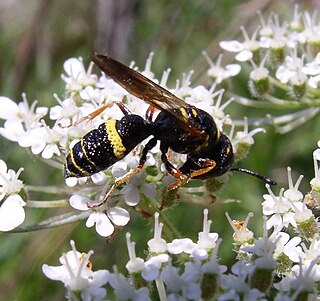
Philanthus gibbosus, which is commonly referred to as a beewolf due to its predation practices, is a species of bee-hunting wasp and is the most common and widespread member of the genus in North America. P. gibbosus is of the order Hymenoptera and the genus Philanthus. It is native to the Midwestern United States and the western Appalachians. P. gibbosus are often observed to visit flowers and other plants in search of insect prey to feed their young. The prey that P. gibbosus catches is then coated in a layer of pollen and fed to the young wasps.

Tetrosomus gibbosus, commonly called camel cowfish because of the hump on its dorsal keel, is one of 22 species in the boxfish family, Ostraciidae. It is a ray finned fish. Other common names include helmet cowfish, humpback turretfish and thornbacked boxfish. It is most closely related to Tetrosomus reipublicae, the smallspine turretfish. T. gibbosus is a species of boxfish found in the wide Indo-West Pacific. It has been recorded since 1988 on rare occasions in the Levantine waters of the Mediterranean Sea, likely following entry via the Suez Canal. It is the first species from the family Ostraciidae to be found in the Mediterranean Sea.
In the 10th edition of Systema Naturae, Carl Linnaeus described the Pisces as:
Always inhabiting the waters; are swift in their motion and voracious in their appetites. They breathe by means of gills, which are generally united by a bony arch; swim by means of radiate fins, and are mostly covered over with cartilaginous scales. Besides the parts they have in common with other animals, they are furnished with a nictitant membrane, and most of them with a swim-bladder, by the contraction or dilatation of which, they can raise or sink themselves in their element at pleasure.

Meadowridge Common is an 8-hectare (20-acre) reserve in the Meadowridge suburb of Cape Town, South Africa, which preserves a fragment of critically endangered Cape Flats Sand Fynbos vegetation.
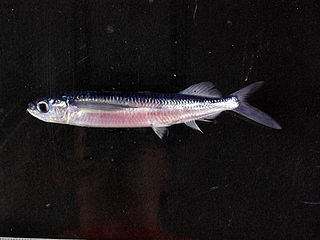
Oxyporhamphus micropterus is a species of halfbeak found in the tropical oceans. Some sources elevate the two subspecies to species rank. Others classify it in the monotypic genus Oxyporhamphus. This taxon is found in the Indo-Pacific region where it is a pelagic, oceanodromous species. It was described by Achille Valenciennes as Exocoetus micropterus in 1847, with the type locality of King George Sound, Western Australia.
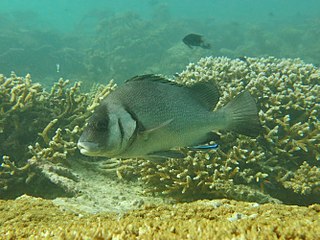
Plectorhinchus gibbosus, commonly known as the Harry hotlips, black sweetlips, brown sweetlips, dusky sweetlips, gibbous sweetlips, hairy hotlips or humpback sweetlips, is a species of marine ray-finned fish, a sweetlips belonging to the subfamily Plectorhinchinae, one of two subfamilies in the family Haemulidae, the grunts. It is native to the Western Pacific and Indian Oceans.

Calothamnus gibbosus, commonly known as corky net-bush, is a plant in the myrtle family, Myrtaceae and is endemic to the south-west of Western Australia. Its distinguishing characteristic is its corky bark in which the hypanthium of the flowers and much of the fruits is buried. Only the petals and stamens emerge from the bark.
Atlanticus gibbosus, known generally as the robust shieldback or robust shield-bearer, is a species of shield-backed katydid in the family Tettigoniidae. It is found in North America.
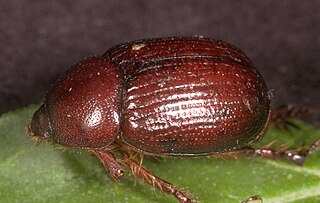
Tomarus gibbosus, the carrot beetle, is a species of rhinoceros beetle in the family Scarabaeidae.
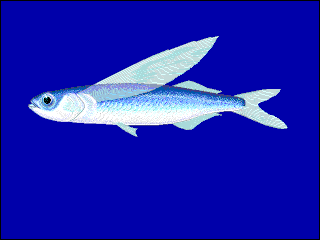
Exocoetus volitans, commonly known as the tropical two-wing flyingfish or blue flyingfish, is a species of ray-finned fish native to tropical and subtropical seas. It can glide above the surface of the sea to escape predators.

Exocoetus obtusirostris, commonly known as the oceanic two-wing flyingfish or the blunt-snouted flyingfish, is a species of ray-finned fish native to the tropical and subtropical western Atlantic Ocean. It has the ability to glide above the surface of the water to escape from predators.

Hirundichthys rondeletii, the black wing flyingfish, is a species of flying fish from the family Exocoetidae which is found throughout the tropical and subtropical waters of the Atlantic, Pacific and Indian Oceans.
Exocoetus peruvianus, commonly known as the Peruvian flyingfish, is a species of ray-finned fish endemic to the tropical southeast Pacific Ocean in the waters off Peru and Ecuador.

The glass headstander,, is a species of fish in the genus Charax. commonly known as the transparent tetra.














